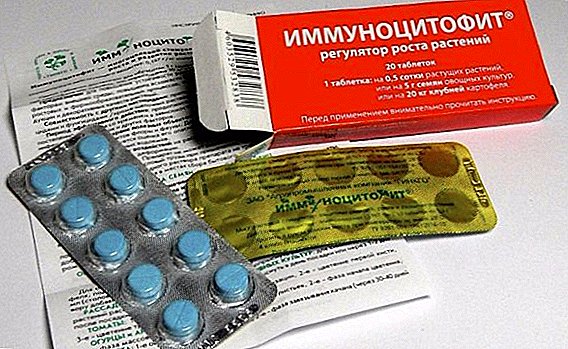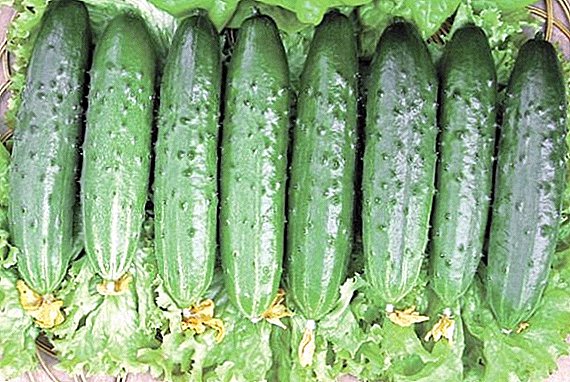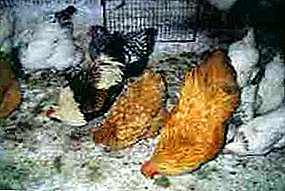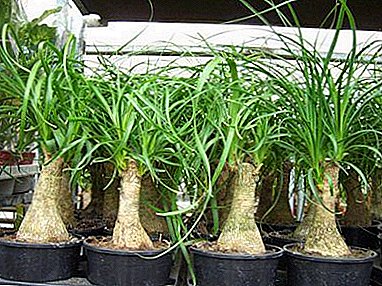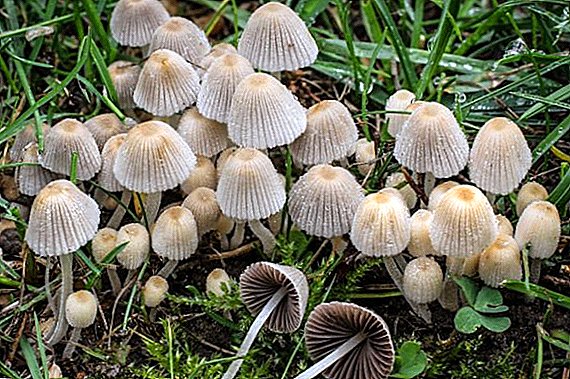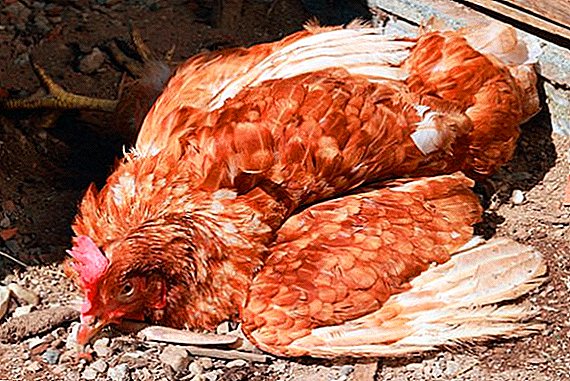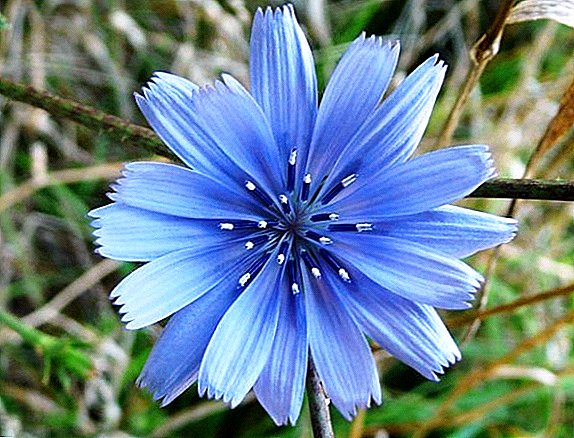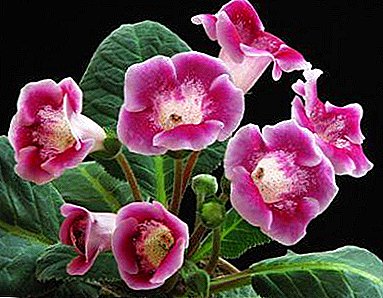
Flowers - like people: grow, develop and are not immune from disease. It would seem that it could threaten under the protection of native home walls or in a cozy summer cottage sheltered from all winds?
However, no green organism is insured against diseases and attacks of harmful insects.
And every owner who loves his blooming corner should know the rules for providing first aid to his fragile pets.
Below we take a detailed look at the photos, what fungal diseases gloxinia can suffer, and also show photos of viral and bacterial infections and show you how to treat the plant, as well as tell you about pest control.
Fungal infections
Late blight

Late blight is the most dangerous fungal disease for gloxinia. On its leaves from the outer side and stems dark brown specks appear.
Causes of late blight disease:
- contaminated soil;
- stagnant water after watering;
- poor root aeration;
- a sharp jump in temperature during the growing season.
This disease can be cured only at the very beginning. Used Bordeaux liquid, copper sulfate or preparations with copper. If there is no result, the plant, unfortunately, must be destroyed.
Mealy dew

This trouble is caused by a fungus with an intricate name Sphaerotheca pannosa. The plant is covered with powdery, whitish spots. At first they are easy to clean.
If the plant is sick with powdery mildew, over time it changes in color, turns brown and becomes denser. The fungus affects the entire plant entirely - from the lower leaves to flowers that alternately dry out.
The most common cause of this contagion is high air humidity (80% and above) at low ambient temperature. The affected areas are treated with weak solutions of potassium permanganate (2 grams per 10 liters of water) or with low concentration of chlorine oxide. If the site is large - washed with a mixture of soap and soda ash (50 grams of both of them on the bucket of water), and then with Dektra, Topaz, Spor. The interval between treatments must be at least 7 days..
In extreme cases, antibiotics can be used: terramycin, streptomycin, penicillin. They are bred in warm water in the ratio of 50/50 and cotton wool sponge thoroughly wash gloxinia several times in a row.
Downy mildew

In this disease, the plant is covered not with whitish, but gray mold, and the affected leaves do not dry out, but become covered with yellowish spots, turn black and fall off. The plant does not die as quickly as with powdery mildew. If the owner misses the moment and the plant falls into a temperature drop (for example, when changing very hot days on cold nights), gloxinia will slowly but surely mold and weaken. The more marshy the soil, the greater the humidity, the more active the process will be.
Of the chemicals suitable oxy and Kuproksat. Processing is carried out 5-6 times every 7 days.
Anthracnose

Or, otherwise, scab is characterized by the appearance of light brown spots - first on the leaves, and then on the stems and flowers.
The disease provokes a lack of potassium in the soil and excessive humidity. In the gloxinia, the affected parts are removed, the stem and leaves are sprayed with a fungicide 3 times in 2 weeks.
Be sure to conduct dressing with a ballast-free potash-phosphorus fertilizer.
Ascohitosis

Red plaques with brown rims - a sign of askokhitozacaused by high humidity in the room. Diseased leaves are burned, and the plant is sprayed with blue vitriol.
Septoria

Excessive humidity and a lack of light provoke this disease. Rust-colored spots appear on the leaves, the stems curl and dry.
In order to avoid this infection, it is better not to take Gloxinia to the open air in wet weather. There should be enough nitrogen in the soil.
With a significant lesion, the plant is best destroyed to prevent infection of its neighbors. If the disease has just begun to develop, you need to remove all the infected parts and treat them with copper or fungicides. Used blue vitriol, Oksihom, Abiga-Peak, Previkur, Ordan, Gold.
Phyllosticosis

If you find the first signs of phyllossticosis - even round spots with a brown middle and leaf breaks - gloxinia must be thoroughly dried and then sprayed with copper sulfate or copper oxychloride.
Fusarium

The root cause is an infected substrate. Shoots are covered with cracks and dark stripes, and the leaves curl and wither. The roots and tuber are washed in a weak solution of potassium permanganate, then gloxinia is transplanted into a new soil. Subsequent treatment with a fungicide is mandatory.!
Gray rot

If gloxinia has become soft and lethargic, its stems rot, and the leaves are captured by a watery gray mold - a gray rot has appeared. The whole thing, as in the previous case, in the soil. It is either too wet or too thick. The plant can be helped to cope with the disease substances Fundazol or Rovral.
It is important not to miss the moment - the treatment is valid only in the first stage.
You can learn more about gloxinia leaf diseases and their treatment here, and more details about why blacken, rot, dry buds can be found here ...
Other ailments
Virose

The vectors of these viral diseases are most often insect pests. The plant decreases resistance to infections and decreases germination of seeds. This trouble can manifest itself in different ways: chlorotic dots on the leaves, strokes of different lengths on the stems and flowers, rotting roots. Unfortunately, viral diseases can not be treated at the moment. The plant will have to be destroyed.
The affected plant can live a long time, and this is a feature of the disease.
Bacteriosis

The pathogen is transmitted through damage, sometimes not visible to the eye. He may fall into the green corner of the owner along with poor quality soil, an unprocessed pot, or other inventory.
In bacteriosis, mucous spots appear on the leaves of gloxinia, growths on the stem and roots. Bacteriosis cannot be treated.
The basic rules of prevention:
- disinfection of instruments, soil and planting containers;
- treatment of fresh wounds on the plant when processing charcoal;
- use of immunostimulants: Appin and Zircon.
Insect pests

- Spider mite. It settles on the back of the leaves, gradually enveloping the web with a plant on all sides. Tiny puncture punctures appear on the leaves - necrotic foci remaining from tick bites. At the same time, the plant dries: when merging, the dots form large dried areas, the decorative appearance of the species is lost, the leaf blades fall off, twisting unnaturally.
It comes with new plants or a gust of wind through an open window. You can use sparing methods of exposure (biological acaricides Vertimek, Fitoverm, Akarin; plant chamomile side by side with gloxinia, marigolds that mites do not tolerate) or carry out chemical acaricides (Omait, Neoron).
Individuals of this species move very quickly, so the affected plant should be immediately transferred to the quarantine zone.
- Cyclamen mite. Colonies of cyclamen mites look like islands of dust on the underside of leaves. Gloxinia loses buds, its stem twists. These insects are easy to bring on street clothes or an umbrella. They can be quickly destroyed by acaricide Akarin, treating the plant 3 times with an interval of 7 days.
- Thrips. They feed on the juice and nectar of the plant, multiply rapidly and are capable of quickly destroying more than one plant. Insects are washed off under the shower, and the leaves and flowers are sprayed with Intavir or Aktar.
- Shchitovka. Shchitovki, having chosen a plant, cover it with a sticky film and, having fixed in one place, pull juice. The plant is washed with a soap solution, a cotton swab shaking off insects, then any insecticidal solution is used.
- White fly. These butterflies breed very quickly, laying on the leaves a lot of larvae.
Be sure to remove the top layer of soil in a pot, cut off the heavily affected leaves, the remaining cover with insecticide.
- Mealybug. These tiny white caterpillar-like insects cover the stems and infect the root system, but are easily destroyed by a solution of green soap, tobacco or garlic infusion. With a large number of individuals help Mospilan, Phyto, Aktar.
Photo pests
Below you can see photos of insects that harm gloxinia.
Spider Tick:

Cyclamen mite:

Thrips:

Shchitovka:

Whitefly:

Mealybug:

Common Problems - Causes and Solution
- Why do the peduncles turn black and the plant wither? The reason may be in the pithy rot caused by overwetting the soil. The soil is abundantly watered with Fundazole, the plant is also sprayed.
- Why is gloxinia drawn out and what should be done in this case? A strongly extended shoot speaks of an excess of nitrogen in the soil, as well as a lack of lighting and excess heat. It is necessary to reduce the temperature of the room with wet cleaning and spraying, often use fitolampy.
- Why is Gloxinia crocheted? The reason - the error of plant care in the home: too high room temperature or drafts. Flower need to highlight a new place.
- Care and cultivation of gloxinia at home.
- We select the right pot for the flower.
- When to remove gloxinia to rest?
- Transplantation and cultivation of gloxinia - instructions and recommendations.
- What to do after gloxinia has faded?
- How to water and feed the plant?
- Features care for the flower at home.
- How to prepare the right soil for gloxinia?
How to reanimate a flower when rotting?
Damaged areas should be cut to a healthy tissue, then soak the tuber in Fitosporin solution for a couple of hours, dry and smear with Maxim.
Conclusion
So, we told how to save a flower from diseases and from rotting. But the main thing that the owner of the green corner should remember is prevention. Constant inspection, attentiveness, accuracy will help the plant to stay healthy and beautiful for a long time. Who, if not a loving owner, better cope with this?


